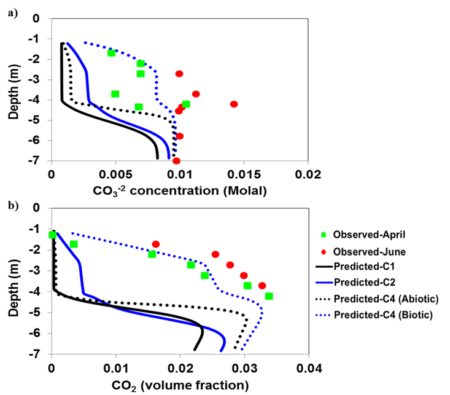
Observed and simulated a) total dissolved carbonate concentrations at well TT-03 and b) CO2 volume fractions at well TT-03. Cases modeled include: C1, abiotic; C2, abiotic+biotic with heterotrophic and chemolithoautotrophic pathways; and C3 with varying temperature gradients.
Scientific Achievement
The objective of this study was to infer the relative contribution of different pathways (such as atmospheric exchange, precipitation/dissolution of carbonate minerals, and biotic heterotrophic and chemolithoautotrophic reactions) on carbon fluxes at a floodplain site in Rifle, Colorado.
Significance and Impact
- Knowledge about the timing and magnitude of CO2 efflux from soils and groundwater represents a significant uncertainty of the global carbon cycle.
- Reactive transport models provide a useful tool for quantifying soil CO2 fluxes and for constraining the extent and rates of different abiotic and biotic reactions.
Research Details
- A 2-D reactive transport model has been developed using TOUGHREACT to explore CO2 dynamics in the saturated and unsaturated zones at the Rifle site.
- Results indicate that observed CO2 fluxes cannot be explained by abiotic reactions alone, but require contributions from microbial activity (e.g., heterotrophic respiration, chemolithoautotrophy).
- The simulated CO2 concentrations are also strongly affected by subsurface temperatures, which vary significantly over time and space at this site.
Citation
Arora, B., Dwivedi, D., Spycher, N. and Steefel, C., 2017. On modeling CO2 dynamics in a flood plain aquifer. Procedia Earth and Planetary Science, 17, pp.408-411. https://doi.org/10.1016/j.proeps.2016.12.103
